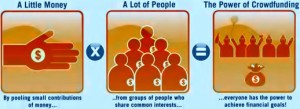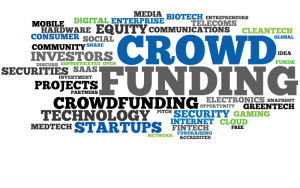Crowdfunding startups – Ways to get your Startup Crowdfunded

Crowdfunding startups | Crowdfunding as the name suggests is using the power of the crowd
Using the power of crowd (general public – outside of a person’s social circle) to finance an intended project with a clear deliverable goal and timeline for execution. While data for 2016 is yet to come in, many analysts were claiming that Crowdfunding would surpass VC funding in a couple of years, if the current growth trends persist. Globally, the Crowdfunding Industry was expected to raise a total of $34 Billion in 2015 (Source: Massolution/Crowdsourcing.org 2015CF Crowdfunding Industry Report).

Crowdfunding currently exists in a variety of categories as listed below:
1.) Peer-to-Peer Lending (P2P) – $25 Bn – Lending for Personal & SME operational needs;
2.) Donations – $2.58 Bn – for Social Causes;
3.) Rewards – $2.68 Bn – Early Adopters (the first to get their hands on prototypes and new launches at discounted prices);
4.) Equity – $2.56 Bn – similar to VCs & Angels, offering equity in exchange of funds;
5.) Royalty – $405 Mn – offering a percentage of revenue from the project or venture, the backer supports, once it generates capital;
6.) Hybrid – $811 Mn – as the name suggests, a mix of the above-mentioned options to secure funds.
P2P Lending hogs the lion’s share of Crowdfunding (70%)
 A Forbes Analysis on the subject states that the market has grown exponentially. In 2010, early adopters contributed $880 Mn to crowdfunding, which rose to $16 Bn in 2014 and was expected to touch $34 Bn in 2015. Furthermore, World Bank projects Crowdfunding to raise $90 Bn by 2017. In contrast, VCs average $30 Bn and Angel Investors average $20 Bn per year in their investments. However, this may not be an apple to apple comparison. Rewards, Equity, Royalty or Hybrid models are of relevance to entrepreneurs with respect to Crowdfunding models.
A Forbes Analysis on the subject states that the market has grown exponentially. In 2010, early adopters contributed $880 Mn to crowdfunding, which rose to $16 Bn in 2014 and was expected to touch $34 Bn in 2015. Furthermore, World Bank projects Crowdfunding to raise $90 Bn by 2017. In contrast, VCs average $30 Bn and Angel Investors average $20 Bn per year in their investments. However, this may not be an apple to apple comparison. Rewards, Equity, Royalty or Hybrid models are of relevance to entrepreneurs with respect to Crowdfunding models.
Claims that Crowdfunding investing will overtake VC & Angel funding seem farfetched if P2P Lending is not included in the list. Even among the 4 models discussed previously, only Equity and Royalty-based models compete very closely with the actual VC investment models. This is to not to insinuate that P2P lending are of no relevance for small businesses or proprietors. A number of SMEs and proprietors tap into the P2P lending model for a line of credit to help grow their businesses without diluting their holding in the company. For a typical startup / entrepreneur knocking on a P2P lender’s door won’t work.
The Indian Scenario:
Crowdfunding in India has always, like many other trends, lagged behind their western counterparts. Importantly, Equity Crowdfunding is yet to be permitted by SEBI in India. SEBI has reached out for consultation on the matter. Even Peer-to-Peer lending seems to be showing some progress with RBI initiating some steps in this regard, which are yet to be formalised. These steps notwithstanding, around 60-70 companies have mushroomed in the P2P space since 2012 & continue their operations till date. Other models of Crowdfunding have had a mixed rate of success in India. Companies such as Fundlined; MakeitNow failed to take off. Others like Pik-A-Venture (2012); Funduzz; YOlaunch; claim to be in Beta Phase for quite a while now.
Excluding P2P Lending platforms, majority of the Crowdfunding platforms in India seem to be for Social Causes (Donation Crowdfunding) followed by creative projects (Reward Crowdfunding) – movie production, music artists, stand-up comedy, art, dance, design, products, photography, publishing, theatre, etc. An early example of commercial crowdfunding in India is the movie Manthan (1976) in which every one of the 5 lakh farmers, members of the Gujarat Co-operative Milk Marketing Federation Ltd., donated Rs.2 towards the project. In today’s digital world, congruent to the crowdfunding that we know of, movies like ‘I Am’ (2010-Hindi) & ‘Lucia’ (2013-Kannada) have successfully raised funds on Crowdfunding platforms and won a number of accolades. Lucia was even deemed a commercial success.
Listed below are some of the Crowdfunding platforms that exist in India currently:
- Social Causes (Donations):
BitGiving; Milaap; Impact Guru; Fund Dreams India; Ketto;
- Creative Projects, Startups (Rewards Based):
Dream Wallets; Catapoolt; Wishberry; Fuel a Dream; Start51;
- P2P Lending:
Faircent; i2iLending; LenDenClub; Lendbox;
How Indian Entrepreneurs use Reward Crowdfunding
A majority of entrepreneurs seeking to crowdfund their ideas rely on rewards-based crowdfunding platforms. These crowdfunding sites levy a 5% platform fee of the intended funding target. Additionally, most of them pass on the bank processing fee, which ranges between 2-5%. So, the total cost for having the pitch hosted on a platform can vary between 8-10% of the total amount being raised. Indians have used a plethora of reward crowdfunding sites for their campaigns such as – Kickstarter; Indiegogo; Wishberry; Fuel A Dream; Dream Wallets; Catapoolt; to name a few. A majority of these sites are free to list on, barring a few, which have a registration/listing fee.
![]()


The Reward Crowdfunding sites have two options:
All Or Nothing (AON) Campaigns – where the entity, creating the pitch, gets funded only if the campaign reaches its funding goal within the designated duration. If the campaign fails to reach its intended amount, then they won’t receive the funds. Also, in such instances, most companies refund the entire amount back to the contributors without deducting any fee.
Keep What You Get (KPWG) Campaigns – are more flexible by allowing the campaign owners to keep the amount raised even if the campaign fails to reach its intended fund-raising target amount. However, some companies that do allow KPWG campaigns tend to charge a higher processing fee as compared to the AON campaigns.
Comparative Table of Crowdfunding Platforms Used by Indians:
| AON / KPWG | Platform Fee | Processing Fee | Target Amount Not Reached for AON | |
|---|---|---|---|---|
| Kickstarter | AON | 5% | 3% + 20c/pledge | Amount is refunded to all the funders |
| Indiegogo | AON & KPWG | 5% | 3-5% (+ $25 if outside of USA) | Amount is refunded to all the funders |
| Wishberry | AON | Rs. 3500 -Registration Fee + 10% (Optional Rs. 35000 as PR Services Consultation Fee) | – | Amount is refunded to all the funders |
| Dream Wallets | AON & KPWG | 5% for AON; 9% for KPWG; | 3% | Contributor Amount minus 6% Processing Fee is refunded back to the Contributor |
| Fuel A Dream | AON & KPWG | 7% + (Rs. 3000 – Registration Fee -Currently Waived as on date) | 2% | Amount is refunded to all the funders (as on date-may change) |
| Catapoolt | Not Specified on website | Rs. 1499 – Registration Fee + Standard – 10%; Premium; – 15%; Advanced – 15% + Mandate; | – | Not Specified on website |
To Conclude:
Crowdfunding is a tough call to make for Entrepreneurs.
The Reward based Crowdfunding platform has some great advantages, some of which are listed below,
- No dilution of equity;
- Early gauging of market interest with minimal financial investment by the entrepreneur;
- Having the early adopters become significant brand advocates, if the product meets their expectations and is a hit. (opens the doors more easily to the investor community, especially if the campaign is oversubscribed);
- Receiving early and fast feedback from a helpful set of early adopters who share your vision for the product;
Conversely, some of the worrisome cons are:
- Lack of privacy and possible IP theft;
- Failure to reach the target finance amount may also affect future funding avenues, potential future Investors worry that it may be a sign of weakness in the product offering;
- Pressure of meeting the expectations of contributors to the project (who may have unrealistic expectations and visions of the product) – example, a social media backlash from disgruntled contributors can sink the product. This is truer for KPWG campaigns, where the contributors expect the promised results irrespective of the finance gap between raised amount and intended amount;
- It takes a great deal of work to build a successful campaign – especially requiring huge investment into creative resources;
- The processing fee does bite into available funds that are made available at the end of the campaign;
This is not to discount that some companies, have had immense success in the Crowdfunding arena. Globally some examples include ‘Pebble’ which raised more than $30 Million in two crowdfunding campaigns against a target of $600,000; BauBax Travel Jacket – called the “Swiss Army Knife of travel wear” -by CNN, raised $9 Million against an intended target of $20,000; Flowhive – a wooden Beehive with an innovative valve which allows beekeepers to harvest & extract honey without harming the bees successfully crossed their intended target of $70,000 and ended up raising over $12 Million.

Closer to home, many Indians are active participants on platforms like Kickstarter. Some of the success stories include – Unrest, a role playing video game raised $36,251 which was more than 12 times its ask amount of $3000. Gecko – a Bluetooth device that helps track things, control music & the camera on a smartphone remotely etc. zoomed in its fundraising when Steve Wozniak put $100 to their campaign and tweeted “I contributed to this – useful as well as prankful”. They successfully raised $135,410 from 3,730 backers against an intended target of $50,000 flexible goal on Indiegogo; Fin – a wearable IOT device raised $202,547 from 1610 backers against a $100,000 flexible goal on Indiegogo.
Lucia – a Kannada film, raised Rs. 51 Lakhs in a span of 31 days through crowdfunding and had a successful commercial launch. Wishberry claims to have listed more than 350 Projects and helped raise Rs. 10.42 Crores to date (10th Jan, 2017). However when one takes a look at the P2P space, the SMEs who need capital for their operational expenses have welcomed this crowdfunding model as an alternative to Banks and Unofficial Money Lenders. This is because they secure funding sans collateral at a competitive interest rate. The sector is garnering huge Investor interest and is touted as the sector to watch in India in 2017 among Investment Circles.
Thus Indian entrepreneurs have had to look at both domestic and international platforms to raise funds through crowdfunding. Weighing the pros and cons startups have to decide whether crowdfunding is the best path for them to trod.






